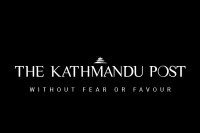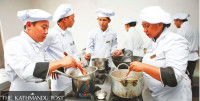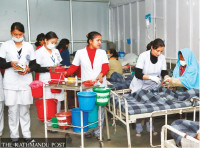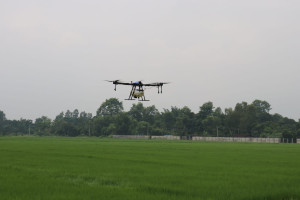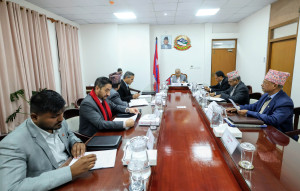Miscellaneous
Toilers by day, students by night
By seven in the evening, a crisp, winter dusk is settling upon the vast expanse of Nandikeshwor Bagaincha in Naxal. The schools have been out for hours now and the children are home turning over the last pages of their assignments or finishing their dinners before bed. But at the south eastern tip of the ground, at Nandikeshwor Bahal, a group of students are only halfway through their classes—their heads bent over the books before them or affixed on a blackboard dimly lit by paraffin lamps. Their classes end only at 9:30 pm.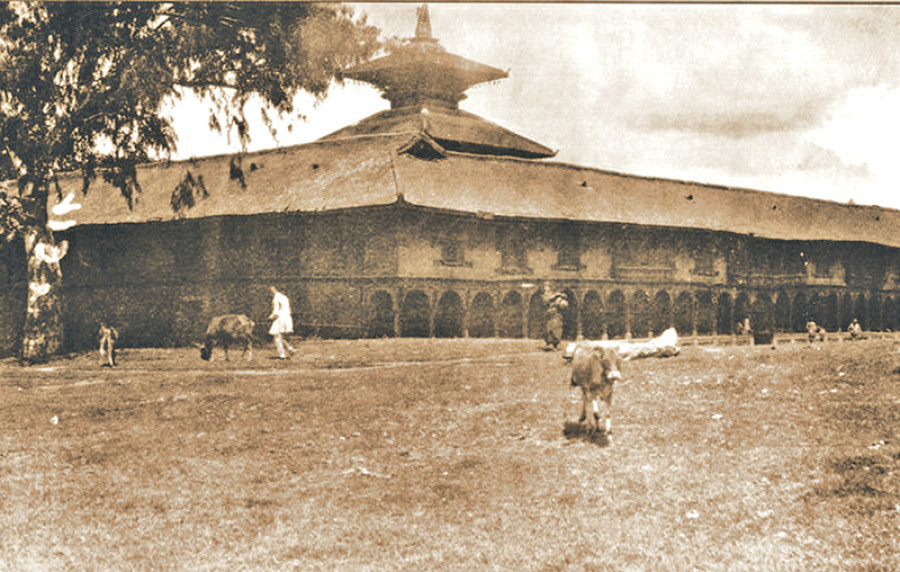
Prawash Gautam
By seven in the evening, a crisp, winter dusk is settling upon the vast expanse of Nandikeshwor Bagaincha in Naxal. The schools have been out for hours now and the children are home turning over the last pages of their assignments or finishing their dinners before bed. But at the south eastern tip of the ground, at Nandikeshwor Bahal, a group of students are only halfway through their classes—their heads bent over the books before them or affixed on a blackboard dimly lit by paraffin lamps. Their classes end only at 9:30 pm.
Many of these students are in their late 20s and 30s, some are even older. By day, the students are full-time workers—some low-level government employees, others domestic workers and manual labourers. Having given up the hope of securing a modern education due to age-barriers, work or financial constraints, these students had found in Ratri Paathshala a cheap and viable platform to reignite their love for learning. And each evening, as the rest of the neighbourhood wound down for the day, they arrived in droves to take advantage of this unique school for adult education.
Since its founding in 1951, Ratri Paathshala has caught thousands of students who fell through the cracks and enabled them to read and complete their schooling and go on to obtain higher education. The first school of its kind, it inspired dozens of similar institutions around the country. But even as most of them closed down with the proliferation of mass education, Ratri Paathshala’s gates continue to remain open today; even if its 70-year history continues to remain largely unknown.
A portrait of Ramji Prasad Aryal, who founded the Ratri Paathshala along with his two brothers—Krishna Prasad and Shiva Prasad Aryal—Mahendra Bahadur Thapa, and Gopinath Sharma. Photo courtesy: Lt Gen (Retd) Durga Nath Aryal
A laughing stock
Nepal has a long history of censorship on education. Its first school, Durbar High School (1854), was meant only for the children of the Rana family. Even when it opened to the public in 1885, the school remained accessible only to select students from the upper echelons of society. Although at the tail-end of the regime, there would be some important steps towards modernising education, they were few and far in between—Juddhodaya High School was established in 1938, Padma Kanya School in 1946 and Padmodaya High School in 1946. Then, with the birth of democracy in 1951, the process of opening new schools expanded further. It was in this background that the Raatri Paathshala was established in March 1951.
At the time, everything about Ratri Paathshala was revolutionary. The adult students, who were largely above 20 years old, went against the grain of what the term ‘student’ connoted. Night classes changed the notion of formal education as being a prerogative of the day-time schools, thus creating space for the employed or others who could not afford to attend schools during the day.
Precisely for the revolutionary nature of the school, its founders, a group of youths from Handigaun led by a teacher Ramji Prasad Aryal (who passed away in 2014 aged 89), received a slew of doubts and rejections.
Aryal, in an article Purano Samjhana, published in the school’s magazine Utthanin 1991, wrote about how Raatri Paathsala was full of promise but also fraught with mockery. “In those days, democracy had sprung like a new day, and we were talking about how best we could use the freedom to contribute to the society.” He further says that they thought that establishing a school for adults would be the best use of the freedom democracy had given them. But it wasn’t easy. Aawaz, a daily newspaper, even published a news story trashing the idea.
But for these spirited men, the mockery only emboldened them. Within days of the publication of the news story, they presented their application, signed by Ramji, his two younger brothers Krishna Prasad and Shiva Prasad Aryal, Mahendra Bahadur Thapa, and Gopinath Sharma, to the Office of the School Inspector, to have their school registered.
Soon afterwards, on April 26, 1951, with Aryal as the founding principal, classes began from the rented premises of a primary school, Nandi Vidhyalaya in Nandikeshwor Bahal, a space which also housed Guruko Paathshala, an elementary school. But merely four months later, as School Leaving Certificate (SLC) examinations approached, they were to learn that a bigger challenge lay ahead. Although they had secured approval to run the school, they were yet to get permission to conduct Sent-Up examinations that qualified students to sit for the SLC exams.
In the same article, Aryal writes that the then Education Secretary, Sardar Rudra Raj Pandey, a teacher and educator himself, had asked the school to present “a clear and detailed syllabus of how they could complete the SLC course in three years (as the school had intended)”, but a 107-page description of their plan did not convince Pandey. Undeterred, as a last resort, the educators made an appeal to the then Education Minister Nrip Jung Rana, but his private secretary brought them his blunt reply, “I won’t meet with anyone from the school that talks rubbish (enabling students to pass SLC with a three-year course) and attempts to fool people.”
According to Aryal, he and his friends followed Rana as he strolled his garden pensively, convincing the minister that their plan was viable. Then, after an hour-and-a-half of back-and-forth, the school was eventually approved under stringent conditions.
The north face of the Nandi Keshar Bahal in Naxal, Kathmandu that housed the Ratri Paathshala (Nandi Ratri School since 1991) until the building was damaged in the 2015 earthquake. The two boards read Nandi Secondary School and Nandi Ratri School respectively. Source: Google Maps
A unique community
With Ratri Paathshala formally established as a secondary school, Nandikeshwor Bahal, began to come to life in the evenings. The students, who needed to be 16 years or older to enrol, were divided into First Year (able to paraphrase the story narrated to them, and solve basic mathematical problems), Second Year (having completed at least the sixth standard) and Third Year (having completed the ninth standard). These classes loosely corresponded with curricula for grades eight, nine and 10 respectively. In 1951, about 150 students enrolled in the First Year level, about 50 in the Second Year and about 10 in the Third Year. A small monthly fee—of Rs three, four and five—were fixed for the three classes respectively.
Tulsi Sayami, 71, a long-time teacher of Nandi Vidhyalaya and a local of Naxal, says that in the initial years, the students were mainly lower-level government employees seeking higher qualification for upward mobility in their places of employment, and Sanskrit students who felt the need of modern education to broaden the range of opportunities available to them. Then lower-rank army and police personnel, who found an opportune mean of completing an education they had left to enlist, began to join as well. All this time, a small number of domestic workers or those employed in low-paid private jobs, formed the central core of the student body.
In spite of the odd-hours of operation, students were not deterred from making long commutes to school, some coming from as far as Gokarna, Sankhu, Bouddha and Patan. And it was this dedication, according to Sayami, that would become the school’s very life force.
Bijaya Kumar Shrestha, 79, was a teacher at the school for three decades and its principal for a decade from 1991. He remembers running into his students plying rickshaws, selling newspapers or engaged in odd jobs during the day. Yet when he entered the classrooms in the evenings, he always found them punctually seated and ready to learn.
“Their dedication and drive was an inspiration to us teachers.” Shrestha says, “For instance, we used to have a domestic worker named Sangat who was extremely poor in his studies. But he worked so hard that by the Second Year, he had transformed into a talented student. Sometimes when teachers were late for the class, he’d keep his fellow classmates engaged in the lessons. The students were here with the burning desire to learn. It really made for a unique, supportive environment.”
Because of the students’ dedication towards studies, the teachers found inspiration to teach, either voluntarily or on low pay, despite the odd hours. Basanta Kumar Sharma, 96, the compiler of Nepali Shabdasagar Shabdakosh, was a voluntary substitute teacher at the school for many years and recalls skipping his classes at Padmodaya High School in order to teach at the Ratri Paathshala.
“We’d talk to our principal to adjust my classes so I could be at Ratri Paathshala on time to take substitution classes. We always knew that the students at Padmodaya would somehow manage. They were more privileged. But the students in Ratri Paathshala were there in the oddest hours and the most difficult circumstances. We never wanted them to miss any classes,” he says.
The teachers were so invested in the project that, according to Sharma, when they learned that the school lacked the funds to construct its own building in 1965, they volunteered to teach without salaries for an entire year so that the money could be diverted towards the construction.
Ratri Paathshala was thus a school where students and teachers shared between them a strong, unspoken bond. Former Deputy Prime Minister and a graduate from the school, Chitra Bahadur KC, 77, shares that a sense of ownership and camaraderie coursed through the long evenings he spent in class. “The teachers and students were both highly hard-working,” he says, “They shared a profound respect for each other and we all had the feeling that this was ‘our school’. As a result not only did the school survive, it began to thrive.”
KC, as many teachers would go on to describe, was a student who summed up the goals the school set out to fulfil. In 1957, KC, then a 17-year-old from Baglung, was dropped off by his father at the home of a relative in Naxal who had promised to send him to school. But instead of going to classes, KC found himself working long hours as a domestic worker instead.
“Eventually, my mother found out about my condition and sent a golden earring for me to pawn off so that I could afford the travel back home,” KC remembers, “But I used that money to rent a room and enrol into Ratri Paathshala instead. I had come to Kathmandu to study, and if it wasn’t for the school I would have never gone on to amount too much in life.”
KC received his SLC certificate after attending classes for three years. He then returned to Baglung to teach at a school before beginning his political career during the pro-democracy movement in the 1980s.
Like KC, many other students went on to occupy important positions in government bodies. Some notable alumni include former Supreme Court Justic Herambaraj Sharma, educator Krishna Bhadra Sharma and Editor-in-Chief of Gorkhapatra, Ramchandra Neupane.
But for a majority of the students, it was the value of education imparted by the school that would be the major takeaway. Shyam Shrestha, 63, remembers being an extremely distracted student when young. “I was fixated with the idea that an education did not matter, only hard work did,” he says, “But when I joined the school at 16, I learned how important education really was. And I made sure that the same values were instilled in my children from the very beginning. We received lessons that went beyond just the textbooks at Ratri Paathshala.”
Rise and fall
As a result of its unique model and a commendable graduation rate, the numbers of students enrolled at the school swelled in the 60s and 70s. At one point, according to teacher Bijay Kumar Shrestha, the student body was as large as 700. Due to the demand for classes, a similar, but morning school for women, Praudh Mahila Mandir, was also eventually established at its premises.
But despite the impact it made, the school would eventually see a gradual decline in enrolment. With the proliferation of mass education in Kathmandu, the demand for adult education began to taper off and Ratri Paathshala was eventually forced to merge with the day school run at the premises after the New Education Policy was implemented in 1972. In 1991, the school split again, with Ratri Paathshala taking up the name Nandi Ratri School (the name it carries today).
After the restoration of democracy in 1990, the overt politicisation of educational institutions would take a further toll on the school. “Then, the fervour to change society and make a positive impact also began to wane,” Shrestha says, “It is a pity that this generation of students and teachers have failed to see the value of an institution like Ratri Paathshala.”
But despite the decline in the number of students, the dedication of teachers and the infrastructure, the school continues to remain in operation. According to Mohan Raj Sharma, the current principal, more than 90 percent of the 200 students over the past five years have been above the age of 20—most of them construction workers, conductors in public vehicles or domestic helpers.
And perhaps it is this inherent spirit of being a space for those from the margins that Ratri Paathshala has continued to carry on despite the many changes it has witnessed. And as long as there are students continuing to enrol for classes, Sharma says, the schools gates will continue to remain open.




 19.12°C Kathmandu
19.12°C Kathmandu

